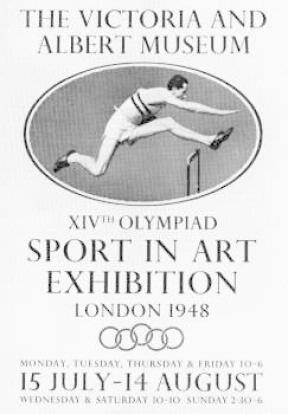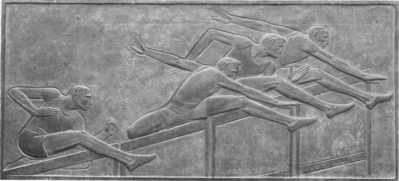
During the first half of the twentieth century, the Olympic Games included competition not only in sports but also in the Fine Arts, just as the ancient Olympic Games did.
I confess that when I first learned this, I thought what a great Monty Python sketch might be written about an international Olympic art competition, with British artists facing off against Italians, French against Germans. But the Olympic art competitions were a serious matter. The modern Olympic Games were established as a way to pursue peace, understanding, and compassion through cooperative competition. The arts were added in the conviction that there’s a relation between aesthetics and arts education on the one hand and moral and social progress on the other.
During the Olympic Games held between 1912 and 1948, medals were awarded in five arts categories: literature, music, painting, sculpture, and architecture. Each piece of artwork submitted had to be inspired by sports.
The arts competition got off to a slow start in 1912, with only 35 artists submitting their work. Nonetheless  gold medals were awarded in all five arts categories. The first significant art competition was at the 1924 Summer Olympics in Paris. Categories and rules differed at different Olympiads. In 1928 four of the five fields of arts competition were subdivided, thus creating more contests and more medals. The literature category, for example, became three separate competitions – for dramatic, epic, and lyric literature. The painting category was split into three different competitions as well: paintings, drawings, and graphic arts. The sculpture category was divided between statues and reliefs or medals. Architecture came to include a town planning category. In 1936 the music category became three events: orchestral, instrumental, and solo or choral music. Musical entries were submitted on paper. It wasn’t until 1936 that the musical compositions were actually performed at the Olympics.
gold medals were awarded in all five arts categories. The first significant art competition was at the 1924 Summer Olympics in Paris. Categories and rules differed at different Olympiads. In 1928 four of the five fields of arts competition were subdivided, thus creating more contests and more medals. The literature category, for example, became three separate competitions – for dramatic, epic, and lyric literature. The painting category was split into three different competitions as well: paintings, drawings, and graphic arts. The sculpture category was divided between statues and reliefs or medals. Architecture came to include a town planning category. In 1936 the music category became three events: orchestral, instrumental, and solo or choral music. Musical entries were submitted on paper. It wasn’t until 1936 that the musical compositions were actually performed at the Olympics.
Prose entries in the literature competition were limited to 20,000 words, about eighty double-spaced typed pages; poetry submissions were limited to a thousand lines. They could be in any language, provided they were accompanied by either an English or French translation.
According to Richard Stanton’s book entitled The Forgotten Olympic Arts Competitions, a total 147 medals were awarded in arts categories over the years. Germany won a total of 24, Italy 14, France 13, and tied with nine medals each were Austria, Denmark, Great Britain, and the United States.
One could imagine that the art of fascist Italy, Germany, and Spain in the late ‘twenties and the ‘thirties might be more martial in style than that of other nations. (The difficulty of judging art from non-western countries wasn’t a significant problem because in those years the Olympics featured almost exclusively European nations.) But the arts competitions ended in 1948 not due to issues of subjectivity in judging art across cultures and nationalities, but because unlike the Olympic amateur athletes, the Olympic artists were generally professionals.
might be more martial in style than that of other nations. (The difficulty of judging art from non-western countries wasn’t a significant problem because in those years the Olympics featured almost exclusively European nations.) But the arts competitions ended in 1948 not due to issues of subjectivity in judging art across cultures and nationalities, but because unlike the Olympic amateur athletes, the Olympic artists were generally professionals.
Originally broadcast on Vermont Public Radio, July 23, 2012. Copyright 2012. Vermont Public Radio.
Photos, Top to Bottom:
1948 Exhibit Poster for London Olympics
“Das Stadion zu Nürnberg,” by Adolf Hensel, First Prize winner in the category of “Designs for Town Planning” for the 1928 Amsterdam Olympics
Hurdle Runners, by Emil Sutor, First Prize winner in the category of “Relief” for the 1936 Berlin Olympics


